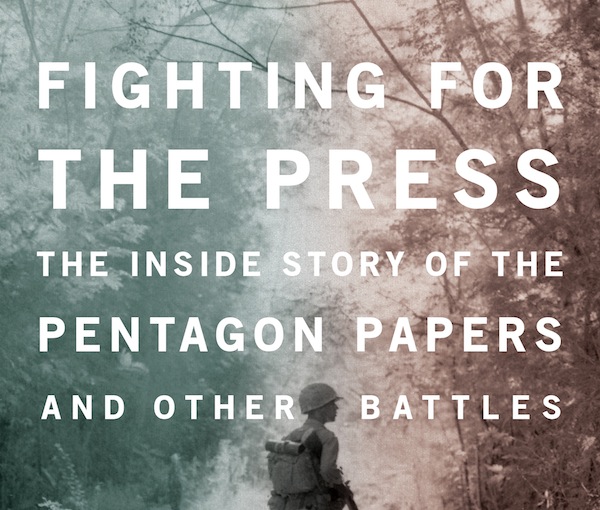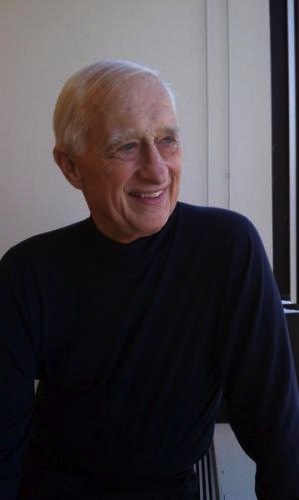Book Review: Fighting the Good Fight for the Press — Publishing the Pentagon Papers
As the individual who quite possibly had the best seats in the house for the monumental legal battle that unfolded over the course of a few weeks in the summer of 1971, James Goodale proffers invaluable morsels of insight and information.
Fighting for the Press: The Inside Story of the Pentagon Papers and Other Battles by James Goodale. CUNY Journalism Press, 260 pages, $20.
By Blake Maddux
Any book about the 1971 publication of the Pentagon Papers has a built-in, albeit limited, audience among journalists, history buffs, and political junkies. Since I am a little bit of all three of these, I was excited when I first heard that James Goodale was writing a book about his experience as the chief legal counsel for the New York Times during the paper’s battle to print the massive top secret study of the United States government’s persecution of the war in Vietnam.
I seem to remember that I first learned of this book while listening a radio interview with Goodale (of whom I had never heard) during the 40th anniversary of the Pentagon Papers in 2011. I was immediately on the lookout as to when I would be able to obtain a copy. Finding nothing on Amazon, I waited. And waited.
This continued to the point at which I was not even sure that the book was ever actually going to appear. In fact, I kind of gave up on it. Thankfully, Goodale’s book Fighting for the Press: The Inside Story of the Pentagon Papers and Other Battles finally hit bookshelves (real and virtual) earlier this year.
From what I can figure, this is Goodale’s first volume for a popular audience. If I were I an editor, I probably would have spilled more than a few drops of red ink on it. As a reader, however, I found Fighting for the Press to be smooth sailing, and would wager that no one would ever guess that it is Goodale’s maiden voyage as an author.
The first chapter begins on June 13, 1971, the day on which the Times published the first Pentagon Papers story. Goodale attributes the muted response to the story primarily to the fact this was also the day after first daughter Tricia Nixon’s wedding. Nixon himself was late getting around to reading the Pentagon Papers piece, and at first concluded that it was worse news for his predecessor (Lyndon B. Johnson) that it was for him.
Like James Dean’s character in Rebel Without a Cause, however, nobody called Nixon chicken without lighting a fire under him. This what Secretary of State Henry Kissinger did, saying that Nixon’s lack of a public response made him look like “a weakling.”
While Goodale is correct to quote Nixon as later saying “subpoena all these bastards [the Times] and bring the case,” he fails to contrast this with what the president had said earlier, perhaps before Kissinger’s words kickstarted his ego: “I wouldn’t prosecute the Times. My view is to prosecute the goddamn pricks that gave it to them.”
Although the exclusion of this quotation does not weaken the book, its inclusion would have made it stronger. The truth is, Nixon was (famously) no fan of the press, yet he was initially reticent to take legal action against the New York Times. Given Goodale’s determination to depict the Pentagon Papers as a major front in Nixon’s war against the press, the absence of this quotation is understandable, though it would have helped illustrate Nixon’s transformation from one view to the other.
Another admittedly minor quibble that is Goodale’s repeated claims that prior restraint is justified only in such a case as someone wanting to publish instructions on how to build a hydrogen bomb.
My guess is that most of the people who read this book are fairly well-versed in matters of the First Amendment. Therefore, I presume that they will recall that a federal court in Wisconsin enjoined The Progressive magazine in 1979 for publishing exactly such information. On appeal, it was revealed that what The Progressive had published was readily available in such anodyne sources as Encyclopedia Americana.
What irked me about Goodale’s multiple mentions of this is that he never specifies if this was a conclusion that he came up with prior to reading The Progressive’s article, or if he saw the article when it came out and decided then and there that that was an instance that would justify prior restraint. There are 160 pages between the first reference of the H-bomb and the only mention of the magazine article, and he never answers this question.
Furthermore, Goodale asserts that a good deal of the Pentagon Papers’ content was drawn from public sources (including the New York Times) and therefore should not be considered classified, let alone subject to prior restraint. He is apparently unwilling to say the same about what The Progressive published and thereby undermines his single example of a justified limit on freedom of the press. Perhaps Goodale is a First Amendment absolutist at heart, but he explicitly claims not to be.
These shortcomings were nowhere near enough to seriously damage the book for me. As the individual who quite possibly had the best seats in the house for the monumental legal battle that unfolded over the course of a few weeks in the summer of 1971, Goodale proffers invaluable morsels of insight and information.
Goodale deftly handles the one-right-after-the-other hearings in New York City and Washington, D.C., where the Washington Post had also published portions of the Pentagon Papers. He undercuts the power of the 1917 Espionage Act over newspapers by succinctly stating that “the government could discipline a leaker, but not a leakee.” He also wisely notes that the New York Times’ victory in the Supreme Court was less than total, as it—per Justice Byron White’s opinion—allowed for criminal prosecution after publication, even if it precluded prior restraint.
Fighting for the Press also includes some moments of levity. Goodale is a graduate of the University School of Chicago Law School, which invariably ranks among the top 10 law schools in the nation. In Goodale’s day, however, that was not the case: “When I interviewed with New York law firms, the comment frequently was, ‘I didn’t know they had a law school out there’.”
Moreover, it was amusing to read about how several of the major players in the Pentagon Papers were, to a certain extent, amateurs.
“My court experience consisted of two uncontested divorce cases,” Goodale says of himself. Alex Bickel, who was probably the most important member of the Times’ legal team, was a highly respected Yale Law School professor and First Amendment scholar “for whom the Pentagon Papers case was his first case ever.” Finally, Murray Gurfein, the first judge to determine if the New York Times should be enjoined from publication, “had just been appointed by Nixon that week to the federal court … This would be his first case as a federal judge.”
Perhaps the most rewarding aspect of Fighting for the Press is how Goodale takes the opportunity to pat himself on the back without climbing atop a pedestal in the process. I had not heard the name James Goodale prior to the 2011 interview that I mentioned earlier. However, Alex Bickel and Floyd Abrams, another member of the Times’ legal team who remains a prominent First Amendment attorney, were quite familiar to me.
Nonetheless, Goodale may very well have been responsible for creating the concept of the “First Amendment lawyer.” Throughout Fighting for the Press, Goodale discusses how lawyers for media companies were “knowledgeable about advertising, circulation and union problems” but “gave scant consideration to what First Amendment rights reporters might have.”
In late 1973, Goodale convened for the first time a group of lawyers that he called the Practising [sic] Law Institute. In the intervening years since the Pentagon Papers case, it had become increasingly common for attorneys to specialize in the First Amendment when representing the media.
Goodale encouraged the lawyers in the group to disobey orders not to print, even at the risk of being found in contempt of court. He also helped promote what he believed should be a universally recognized reporter’s privilege, whereby journalists could keep their sources confidential if those seeking such information could not demonstrate, through a strict “three-part test” that Goodale developed, that knowing the name of the source was necessary.
Goodale writes, “Through the efforts of the First Amendment Bar, which I created, the reporter’s privilege was recognized in all but two states: Wyoming and Hawaii.”
Clearly, Goodale has been an indispensable figure in enforcing the guarantees of the First Amendment. That he has been so even when there were no cameras or microphones pointed at him makes his efforts all the more admirable.
Blake Maddux is a freelance journalist and regular contributor to DigBoston and The Somerville Times. He recently received a master’s degree from Harvard Extension School, which awarded him the Dean’s Thesis Prize in Journalism. A native Ohioan, he moved to Boston in 2002 and currently lives with his wife in Salem, Massachusetts. He will be teaching a class during the winter term on the First Amendment in American History at the Cambridge Center for Adult Education in Cambridge, MA.


